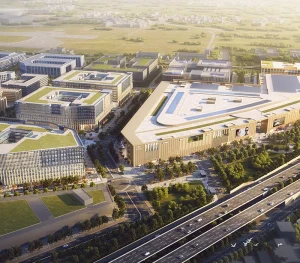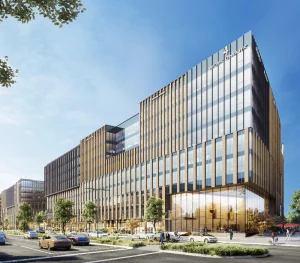GBD | August 12, 2025
How Worldmark Compares to Canary Wharf and DIFC
With cities vying for global talent and capital, Global Business Districts (GBDs) are the urban currency of choice. These districts are not just defined by skyscrapers or office density, but by their ability to foster economic activity, provide seamless connectivity, and offer integrated, human-centric environments. Globally, only names such as London’s Canary Wharf and the UAE’s Dubai International Financial Centre (DIFC) have been the gold standard for years. However, today, a new name is emerging with credibility and scale, Worldmark Aerocity in the capital of India, New Delhi. In the fast-evolving dynamics of Asia-led growth, Worldmark vs Canary Wharf, or Worldmark vs DIFC, debate could not be more topical. This blog provides a comparative, in-depth analysis of how Worldmark compares against these internationally recognized GBDs.
An Overview of Canary Wharf and DIFC
One of the world’s best-known financial hubs, Canary Wharf is located in London’s former Docklands. Established in the 1980s and 90s, it now provides more than 16 million square feet of retail and commercial space. The district has long been a stronghold for global banking and finance giants such as Citigroup, Barclays, and HSBC, alongside legal and media firms. Canary Wharf, despite its success, is in transformation. According to the UK Times, the district is presently facing a switch in occupier preference in the direction of more central locations, resulting in an increase in vacancy and a transition into mixed-use forms consisting of residential and life sciences.
The Dubai International Financial Centre (DIFC) is the Middle East’s strongest effort at creating a GBD. Opened in 2004, DIFC measures 110 hectares and provides a special financial environment based on an English common law framework. It hosts more than 6,900 firms and approximately 46,000 professionals. In 2024, DIFC’s revenues were AED 1.78 billion, and profits had increased by 55% compared to the last year (The Fintech Times). It is also a successful haven for hedge funds, family offices, and fintech, 48 of which are valued at over a million dollars. Its success stems from regulatory independence, tax-free benefits, and a high concentration of financial services.
Comparison of Key Metrics
If we look at hard data and strategic essentials, Worldmark, Canary Wharf, and DIFC comparison makes sense. Canary Wharf is 16 million sq. ft., DIFC spans around 11 million sq. m (110 hectares), whereas Worldmark India will provide over 20 million sq. ft. of smart space within its four phases, Worldmark 1.0, 2.0, and 3.0, and 4.0 Worldmark 1.0 set the tone with 1.5 million sq. ft., and currently, Worldmark 2.0 alone is contributing 6.3 million sq. ft. of combined commercial space, the biggest privately planned business district in India.
At a tenant level, Canary Wharf traditionally leans towards banks and financial institutions, while DIFC has diversified into fintech, insurance, and hedge funds. Worldmark is drawing in a broad spectrum, ranging from international corporates to high-end Indian businesses, underpinned by adaptable floorplates (up to 150,000 sq. ft.), co-working areas, and built-to-suit, particularly in 4 Worldmark and The Business Suites.
At a connectivity level, all three are strategically located. Canary Wharf is well served by the London Underground, Docklands Light Railway, and the Crossrail/Elizabeth Line. DIFC benefits from proximity to Dubai International Airport and its metro system. However, Worldmark India distinguishes itself with multi-modal, multi-scale connectivity, placed within the ecosystem of IGI Airport, served by five national highways, three metro lines, including the Airport Express, and set to benefit from upcoming infrastructure such as the NaMo Bharat Rapid Rail and the proposed Air Train. As for Worldmark, the Rangpuri bypass tunnel that is proposed will provide smooth road access from South Delhi and Vasant Kunj through the Shivmurti Interchange, positioning Worldmark at the heart of a hyper-connected area.
On the people front, Canary Wharf hosts over 100,000 employees, DIFC has 46,000 professionals, while Worldmark is projected to serve a catchment area of over 300,000 daily workers in Aerocity. With nearly 33.8 million people in Delhi’s metropolitan area and projected urban expansion, Worldmark’s surrounding workforce and consumer base could outstrip its global peers within the next decade.
Worldmark’s Differentiators
What distinguishes Worldmark Aerocity is not only its size or connectivity, but the way it is integrating business with experience. Worldmark is founded on a vision that blends aspiration and activation, composing a live, dynamic district, rather than a static agglomeration of buildings. The district is a greenfield master-planned model, as compared to Canary Wharf’s development from re-purposed docks or DIFC’s anchorage around regulatory innovation. Worldmark 2.0 begins with the user, 12 check-in counters per building, 8,000+ parking bays linked via tunnel basements, IGBC-certified buildings, and majestic lobbies that elevate everyday office interactions.
The retail and lifestyle factor also surpasses most conventional GBDs. Worldmark 2.0 features World St., a 365-metre-long curated F&B high street, which is proposed to be open 24/7, and Manhattan Drive, a boulevard featuring boutique retail and daily conveniences. The future Haute District is being touted as India’s most luxurious shopping boulevard, with premium brands, anchors, and the largest indoor location-based entertainment zone in the country. The district is structured to draw not only tenants but individuals, making it a place where businesses, employees, families, and travellers coexist.
Culturally, Worldmark incorporates a distinctive sense of place. From open-air commons and interactive public art to fit-out displays and tenant narratives, the brand’s communications are anchored in aspiration and prestige. There are no aggressive pitches, just powerful stories around future-readiness, wellness, and global ambition.
Worldmark’s vision of becoming India’s finest GBD is accentuated by India’s high-growth market potential, strong digital infrastructure, and macroeconomic stability. As more MNCs look to enter or expand in India, Worldmark offers them a headquarters-grade environment with the lifestyle appeal of an Aerocity address, something that didn’t exist before at this scale. The blend of Grade-A offices, premium high street retail, walk-to-work hotel access, and proximity to the airport makes Worldmark one of the most differentiated mixed-use campuses in the Asia-Pacific region.
Final Thoughts
GBD comparison of Worldmark vs Canary Wharf, or Worldmark vs DIFC, brings forth a significant reality: India is no longer imitating the global model; it’s creating its own. While Canary Wharf emerged as a result of financial sector decentralisation and DIFC from legal innovation, Worldmark bases itself on holistic urbanism. It is an expression of a greater insight into what the next generation of global businesses need: connectivity, flexibility, culture, sustainability, and most importantly, aspiration.
With over 20 million square feet of developed infrastructure, unbroken connectivity to India’s busiest airport, access to talent-rich locations, and compelling experiences that marry retail, leisure, and business, Worldmark at Aerocity, New Delhi isn’t keeping pace with the world’s peers; it’s quietly charting a new generation of GBDs for a hybrid, globalised, and culturally diverse economy.
For companies desiring a strategic location in India, for CXOs planning to signal scale, or for startups planning their flagship address, Worldmark provides a space that’s on par with the best of Canary Wharf and DIFC, but designed for the realities of business tomorrow. It’s not merely a comparison; it’s a redefinition of what global business districts should look like.




